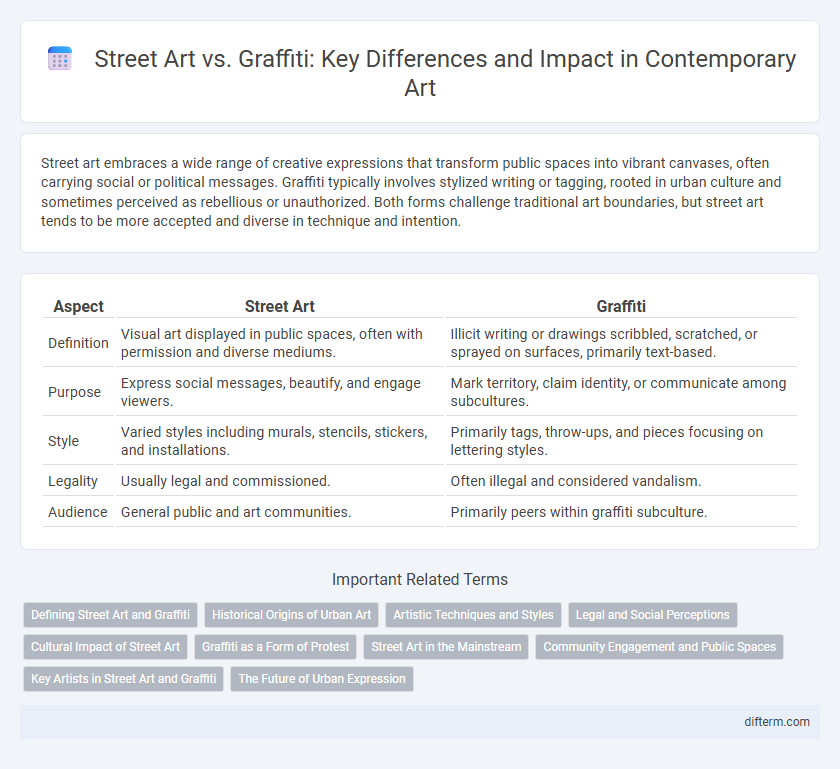Street art embraces a wide range of creative expressions that transform public spaces into vibrant canvases, often carrying social or political messages. Graffiti typically involves stylized writing or tagging, rooted in urban culture and sometimes perceived as rebellious or unauthorized. Both forms challenge traditional art boundaries, but street art tends to be more accepted and diverse in technique and intention.
Table of Comparison
| Aspect | Street Art | Graffiti |
|---|---|---|
| Definition | Visual art displayed in public spaces, often with permission and diverse mediums. | Illicit writing or drawings scribbled, scratched, or sprayed on surfaces, primarily text-based. |
| Purpose | Express social messages, beautify, and engage viewers. | Mark territory, claim identity, or communicate among subcultures. |
| Style | Varied styles including murals, stencils, stickers, and installations. | Primarily tags, throw-ups, and pieces focusing on lettering styles. |
| Legality | Usually legal and commissioned. | Often illegal and considered vandalism. |
| Audience | General public and art communities. | Primarily peers within graffiti subculture. |
Defining Street Art and Graffiti
Street art consists of visual artwork created in public spaces, often conveying social or political messages, and is typically more accessible and diverse in style compared to graffiti. Graffiti primarily involves writing or symbols scribbled, scratched, or painted illicitly on walls or surfaces, focusing on tagging, names, or messages that emphasize identity and presence. Both forms use urban environments as canvases but differ in purpose, legality, and artistic expression within contemporary street culture.
Historical Origins of Urban Art
Street art and graffiti both trace their origins to the late 20th century urban environments, with graffiti emerging prominently in 1960s Philadelphia and New York City as a form of territorial tagging and self-expression. Street art evolved from graffiti but incorporates broader techniques such as stenciling and murals, gaining recognition as a legitimate art form in the 1980s. The historical origins of urban art reflect complex social, political, and cultural dynamics within marginalized communities, influencing contemporary art movements worldwide.
Artistic Techniques and Styles
Street art often employs stenciling, wheat-pasting, and mural painting to create vibrant, accessible visuals that interact with urban environments, emphasizing composition and thematic storytelling. Graffiti prioritizes freehand spray painting, tagging, and wildstyle lettering, showcasing spontaneous expression and intricate letterforms rooted in hip-hop culture. Both styles utilize color theory, layering, and contrast to evoke emotion, yet street art leans toward representational imagery while graffiti focuses on stylized typography.
Legal and Social Perceptions
Street art often gains legal acceptance through permits and community projects, fostering positive social perceptions as a form of public beautification and cultural expression. Graffiti typically faces stricter legal penalties due to its association with vandalism and property damage, contributing to negative social stigma despite its roots in urban culture. The evolving dialogue around both highlights the tension between artistic freedom and property rights within urban environments.
Cultural Impact of Street Art
Street art significantly influences urban culture by transforming public spaces into vibrant expressions of social commentary and community identity. Unlike graffiti, which often carries connotations of illegality and rebellion, street art is increasingly recognized as a legitimate art form that promotes cultural dialogue and revitalizes neighborhoods. This form of visual communication fosters inclusivity and reflects diverse socio-political narratives, creating a lasting cultural impact on contemporary urban environments.
Graffiti as a Form of Protest
Graffiti serves as a powerful form of protest by transforming urban spaces into canvases that voice social and political dissent. This art form often challenges authority and highlights marginalized perspectives, creating immediate and visible statements that demand attention. Its raw, unfiltered expression distinguishes it from street art, making graffiti a crucial tool for grassroots activism and public resistance.
Street Art in the Mainstream
Street art has increasingly gained mainstream acceptance as a legitimate form of urban expression, transcending its roots in rebellion and subculture. Renowned artists like Banksy and Shepard Fairey have propelled street art into galleries, commercial spaces, and popular culture, influencing fashion, advertising, and social commentary. This shift reflects the evolving perception of street art as a valuable contribution to contemporary art and public dialogue.
Community Engagement and Public Spaces
Street art transforms public spaces into vibrant galleries, fostering community engagement by reflecting local culture and social issues. Unlike graffiti, which often carries a rebellious connotation and lacks formal permission, street art invites dialogue and collaboration, enhancing neighborhood identity. Murals and installations encourage residents to take pride in their environment, promoting inclusivity and civic participation.
Key Artists in Street Art and Graffiti
Banksy revolutionized street art with his politically charged stencils, blending social commentary and anonymity to captivate global audiences. Jean-Michel Basquiat transitioned graffiti into the gallery scene, merging raw urban expression with neo-expressionist art that challenges traditional norms. Shepard Fairey's iconic "Obey Giant" campaign fuses graphic design and street culture, emphasizing activism and bold visual impact.
The Future of Urban Expression
Street art and graffiti continue to evolve as powerful forms of urban expression, blending traditional techniques with digital innovations like augmented reality to engage a broader audience. Cities worldwide are incorporating legal walls and community projects, fostering collaboration between artists and local governments to legitimize and preserve these art forms. The future of urban expression lies in sustainable practices and interactive installations that challenge social norms while enhancing public spaces.
street art vs graffiti Infographic

 difterm.com
difterm.com